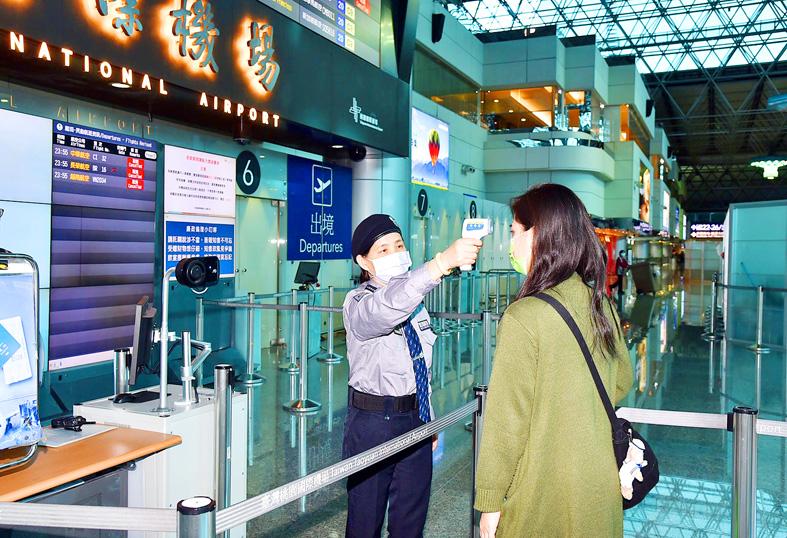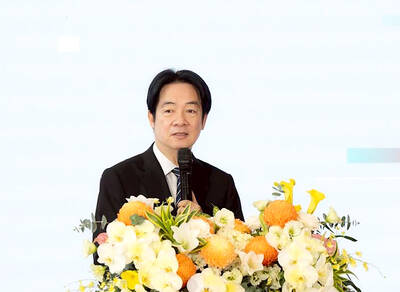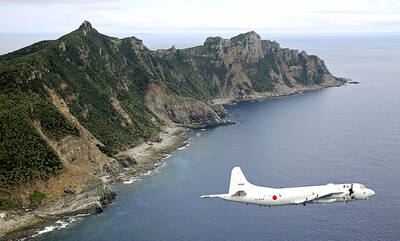The Central Epidemic Command Center (CECC) yesterday reported three new cases of COVID-19, including two airline employees.
The two flew on the same plane as a Taiwanese pilot who was confirmed to have COVID-19 on Friday, indicating a cluster of infections in the flight cabin, the CECC said.
The pilot, case No. 760 in the nation, flew to the US on Dec. 12, returned on Wednesday, began showing symptoms during quarantine at the airline’s dormitory and tested positive for COVID-19 on Friday, said Centers for Disease Control Deputy Director-General Chuang Jen-hsiang (莊人祥), the CECC’s spokesman.

Photo courtesy of Taiwan Taoyuan International Airport
One of the new cases, No. 765, is a New Zealander in his 60s who flew to the US on Nov. 29, returned to Taiwan on Dec. 4 and flew to the US again on the same flight with case No. 760 on Dec. 12, during which he was reportedly coughing, Chuang said.
He returned to Taiwan on Tuesday and had been under home quarantine, but after case No. 760 was confirmed, he was tested the same day, and the result came back positive yesterday, Chuang said.
The man also tested positive for antibodies against COVID-19, he added.
Case No. 766 is a Japanese man in his 20s who flew to the US on Dec. 5, returned to Taiwan on Dec. 7, flew to the US again on the same flight with case Nos. 760 and 765 on Dec. 12, and returned to Taiwan on Tuesday.
On Thursday, he reported that he was coughing and was tested on Friday, Chuang said, adding that he developed diarrhea on Saturday and his test result came back positive yesterday, but an antibody test came back negative.
The three cases are likely a cluster of infections that occurred within the airplane cabin, Chuang said, adding that case No. 765 is most likely to be the source, as he has a higher cycle threshold value (CT value) of 24.9 and has developed antibodies against COVID-19.
The CT values of cases 766 and 760 were 15.2 and 17 respectively, he said.
A higher CT value indicates lower viral load and a lower risk of infectivity.
Case No. 765 first flew to the US on Nov. 29 and returned to Taiwan on Dec. 4, so if he contracted the disease during the period, he would still be infectious during the flight on Dec. 12, Chuang said, adding that his colleagues reported that he had been coughing without a mask during the flight.
The CECC found that case No. 765 left the airline dormitory during his rest days from Dec. 8 to Dec. 11, so contact tracing personnel are examining his iPad to find out where he was during the period.
Asked if the Taiwanese airline is at fault for letting crew members with symptoms work in a plane without wearing a mask, Chuang said case No. 765 said he did not have any symptoms, but was reported to be coughing, so the center would ask the Civil Aeronautics Administration and the airline to investigate and clarify the situation.
The third new case reported yesterday is an Indonesian man in his 40s, who came to Taiwan for work on Dec. 3 and had provided a negative polymerase chain reaction test result from within three days before departing.
He did not show any symptoms in Taiwan, Chuang said.
The shipping service company he works for paid for a COVID-19 test when his quarantine ended on Friday and the result came back positive yesterday, he said.
Eight crew members who work on the same ship have been placed under home isolation, he added.

MISINFORMATION: The generated content tends to adopt China’s official stance, such as ‘Taiwan is currently governed by the Chinese central government,’ the NSB said Five China-developed artificial intelligence (AI) language models exhibit cybersecurity risks and content biases, an inspection conducted by the National Security Bureau (NSB) showed. The five AI tools are: DeepSeek, Doubao (豆包), Yiyan (文心一言), Tongyi (通義千問) and Yuanbao (騰訊元寶), the bureau said, advising people to remain vigilant to protect personal data privacy and corporate business secrets. The NSB said it, in accordance with the National Intelligence Services Act (國家情報工作法), has reviewed international cybersecurity reports and intelligence, and coordinated with the Ministry of Justice Investigation Bureau and the National Police Agency’s Criminal Investigation Bureau to conduct an inspection of China-made AI language

LIMITS: While China increases military pressure on Taiwan and expands its use of cognitive warfare, it is unwilling to target tech supply chains, the report said US and Taiwan military officials have warned that the Chinese People’s Liberation Army (PLA) could implement a blockade within “a matter of hours” and need only “minimal conversion time” prior to an attack on Taiwan, a report released on Tuesday by the US Senate’s China Economic and Security Review Commission said. “While there is no indication that China is planning an imminent attack, the United States and its allies and partners can no longer assume that a Taiwan contingency is a distant possibility for which they would have ample time to prepare,” it said. The commission made the comments in its annual

‘TROUBLEMAKER’: Most countries believe that it is China — rather than Taiwan — that is undermining regional peace and stability with its coercive tactics, the president said China should restrain itself and refrain from being a troublemaker that sabotages peace and stability in the Indo-Pacific region, President William Lai (賴清德) said yesterday. Lai made the remarks after China Coast Guard vessels sailed into disputed waters off the Senkaku Islands — known as the Diaoyutai Islands (釣魚台) in Taiwan — following a remark Japanese Prime Minister Sanae Takaichi made regarding Taiwan. Takaichi during a parliamentary session on Nov. 7 said that a “Taiwan contingency” involving a Chinese naval blockade could qualify as a “survival-threatening situation” for Japan, and trigger Tokyo’s deployment of its military for defense. Asked about the escalating tensions

DISPUTE: A Chinese official prompted a formal protest from Tokyo by saying that ‘the dirty head that sticks itself out must be cut off,’ after Takaichi’s Taiwan remarks Four armed China Coast Guard vessels yesterday morning sailed through disputed waters controlled by Japan, amid a diplomatic spat following Japanese Prime Minister Sanae Takaichi’s comments on Taiwan. The four ships sailed around the Senkaku Islands — known as the Diaoyutai Islands (釣魚台) to Taiwan, and which Taiwan and China also claim — on Saturday before entering Japanese waters yesterday and left, the Japan Coast Guard said. The China Coast Guard said in a statement that it carried out a “rights enforcement patrol” through the waters and that it was a lawful operation. As of the end of last month,